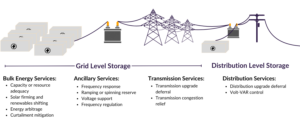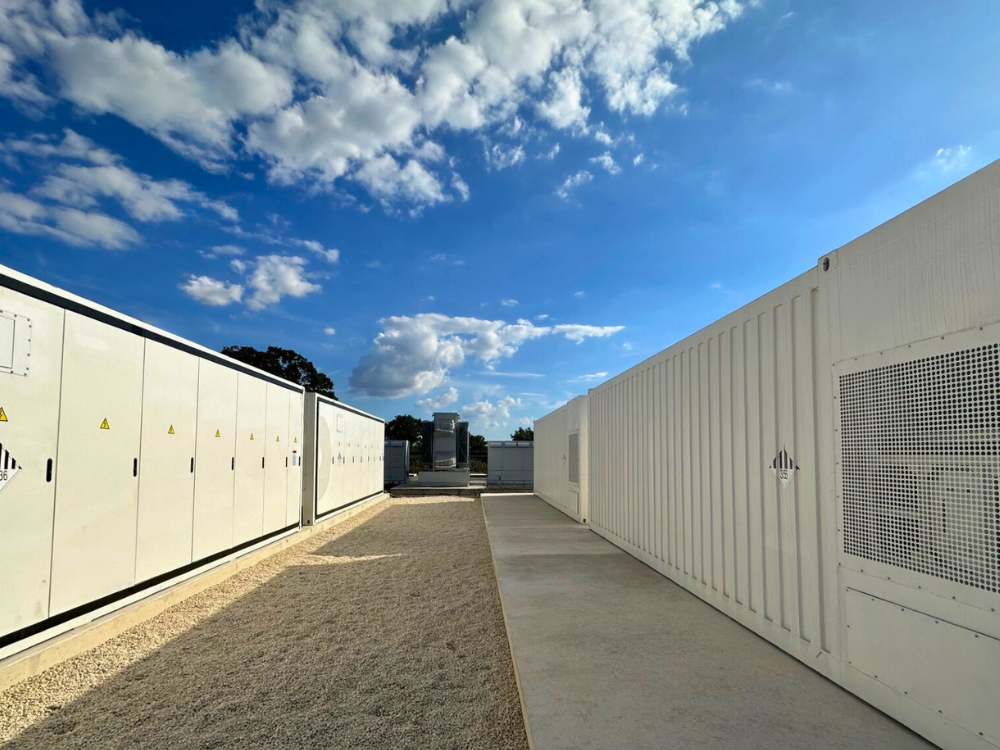Frequently asked questions about utility-scale battery energy storage systems (BESS)
General energy storage questions
-
What is a utility-scale battery energy storage system?
Utility-scale or grid-scale battery storage refers to technologies connected to the power grid that can store energy in rechargeable batteries and then supply it back to the grid. Without energy storage, electricity must be produced and consumed at exactly the same time. Energy storage systems allow electricity to be stored—and then discharged—at the most strategic and vital times, and locations.
-
How do utility-scale battery energy storage systems (BESS) work?
Battery energy storage systems can gather and store energy from either the grid directly or from an adjoining solar farm or other power source. The energy is stored in rechargeable batteries and then can be strategically deployed when needed most. The most commonly deployed form of energy storage today is lithium-ion battery storage, which leverages similar technology as your cell phones and laptops. In the case of battery energy storage systems, this is just on a much larger scale, with more extensive requirements for certification and safety.
Learn more about how these systems store and deploy energy in BESS 101.
-
What does a typical energy storage project look like?
Battery energy storage systems (BESS) come in many different shapes and sizes but are typically smaller than a 40’ shipping container. BESS containers, which hold the battery components, are set directly on concrete foundations and the ground area around them is covered in crushed rock, similar to a substation.
Major components of a battery energy storage system are:

Learn more about battery energy storage systems and how they work in: BESS 101
-
What are the advantages of energy storage?
Energy storage brings a number of benefits to customers, communities, and the grid: from maintaining a steady supply of clean energy to reinforcing our grid. Storage increases grid flexibility and helps provide uninterrupted power for consumers, businesses, and other users. These systems lower electricity costs while diversifying our energy mix for energy security and independence.
Click here for a full overview of benefits.
-
Can energy storage work with all fuel sources?
Yes, energy storage systems are technology- and fuel-neutral. Battery systems can be charged by renewable energy sources, or can be charged directly from the grid. Electricity from the grid can be generated by any number of technologies, including renewables like solar as well as oil, natural gas, coal, and nuclear power.
-
How does storage reduce energy costs?
- Utility-scale battery energy storage systems (BESS) supports the integration of more, low cost renewable energy generation that is now the cheapest source of electricity worldwide. Along with affordable electricity, adding renewables to our energy mix increase our nation’s energy security.
- BESS improves grid efficiency: Energy storage is instantly dispatchable to function both as generation and load, so it can help the grid adjust to fluctuations in demand and supply, which optimizes grid efficiency, alleviates transmission congestion, and increases grid flexibility. This reduces overall system costs.
- BESS helps limit the need for costly energy imports and increases energy security: Energy storage improves energy security and maximizes the use of affordable electricity produced in the United States.
- BESS helps prevent and minimizes power outages: Energy storage can help prevent or reduce the risk of blackouts or brownouts by increasing peak power supply and by serving as backup power.
-
Are storage systems useful for communities?
Battery energy storage systems are beneficial for communities because of a whole range of indirect benefits they generate. They support energy independence by reducing local reliance on traditional fossil fuels and imported fuel sources to be reduced, and they also make the power grid more efficient and stable, protecting it from malfunctions or blackouts. Energy storage improves energy security and maximizes the use of low-cost, home-grown renewable electricity produced in the United States.
Health and safety
-
Are utility-scale battery energy storage systems safe?
Yes. Utility scale battery energy storage systems use very similar lithium ion technology as cell phones and devices that are in our pockets each and every day. However, battery storage modules, containers and sites are held to additional safety standards and undergo supplemental testing.
As part of UL 9540A, batteries are tested for safety at different levels which depending on system design may include cell, module, unit, and installation level.
On top of the rigorous testing done from the cell to container level, there are additional safeguards implemented on BESS sites. This includes an aggregate 24/7 monitoring and alarm system with backup power.
NFPA 855 “Standards for the installation of Energy Storage Systems” standards are also implemented on BESS sites. These requirements include spacing between containers, ingress and egress requirements, proximity to flammable items, etc.
Lastly, all developers/owners are required to develop a Hazard Mitigation Analysis (HMA) which is an evaluation and report of potential energy storage system failure modes and the safety related consequences attributed to a failure. This includes an Emergency Response Plan (ERP) that prescribes processes and procedures fire responds shall follow should a failure event occur on site. The local authorities are trained on the ERP prior to project operation and on an annual basis for the life of the project.
Resource: American Clean Power Fact Sheet
-
Do batteries produce noise?
Batteries alone do not make any noise. Noise is generated from the fans and chillers that are used to cool the batteries during charging and discharging. The systems themselves are installed at a distance to mitigate noise. Lightsource bp will conduct analysis of maximum sound levels emitted from the BESS and ensure compliance with all applicable requirements.
-
What is Lightsource bp’s approach to BESS fire safety?
Lightsource bp works with licensed third-party fire protection engineering experts to develop comprehensive fire safety strategies specific to each battery energy system’s technology and configuration. We also work closely with the communities we join and their fire departments on thorough safety communications and training. Additionally, Lightsource bp’s BESS offerings have all been subjected to full-scale fire testing as per UL 9540A.
Learn more about how we ensure safe, reliable energy storage systems on our Safety Page.
Resource: American Clean Power Fact Sheet
-
What certification requirements are there for BESS?
All Lightsource bp BESS deployments will follow required fire codes. As part of this, our energy storage systems will utilize containers and technologies that have conducted UL 9540A test procedures.
UL 9540A is the Installation Level Tests with Outdoor Lithium-Ion Energy Storage Systems. Via these test procedures, BESS containers are positioned adjacent to each other as they would be at real energy storage sites, then an individual battery module (called the event module) is forced into thermal runway (extreme heat).
The data from this test is used by safety experts including licensed Fire Protection Engineers to confirm that the safety features and protections of the BESS container function as intended and can support a safe and reliable BESS facility.
Lightsource bp will utilize and follow National Fire Protection Agency (NFPA) 855 design standards. NFPA 855 is the Standard for the Installation of Energy Storage Systems.
Resource: American Clean Power Fact Sheet
Energy storage technical questions
-
How does BESS support the grid?
Battery energy systems enhance grid reliability by making power accessible when needed. BESS can serve as a dependable power source in extreme weather events or in the case of equipment failure. These systems match power supply and demand, making the grid more resilient and efficient.
-
What is the difference between energy storage capacity and duration?
Power capacity is the maximum amount how much electric power an energy storage system can charge or deliver in megawatts (MW), while duration is how long it can do so in hours. A megawatt-hour (MWh) is typically the unit used to describe the amount of energy a battery can store, in megawatts multiplied by hours.
Take, for instance, a 240 MWh lithium-ion battery system with a maximum capacity of 60MW. That battery can deliver 60MW for 4 hours.
-
How are battery energy storage systems monitored?
Battery energy storage systems are monitored 24/7. SCADA (supervisory control and data acquisition) is a control system that enables monitoring of the battery energy storage system. SCADA focuses on real-time monitoring, control, and data acquisition of the BESS itself, and works in tandem with the EMS (energy management system) which takes a broader view, optimizing the operation of the entire power system, including the BESS, to ensure efficient and reliable energy management.
Battery energy storage systems are equipped with sensors that track battery temperatures and enable storage facilities to turn off batteries if they get too hot or too cold.
-
Where are these batteries located?
Utility-scale BESS can be deployed in several locations, including: 1) in the transmission network; 2) in the distribution network near load centers; or 3) co-located with renewable energy generation. The siting of the BESS has important implications for the services the system can best provide, and the most beneficial location will depend on its intended use.

Energy storage system decommissioning
-
How long do batteries last?
Batteries typically have a lifespan of at least 20 years, however depending on usage, the batteries may still have usable capacity after 20 years.
-
What happens when batteries reach their end of life?
Lightsource bp is committed to reusing and recycling as much of our materials as possible, at the end of our projects and throughout their lifespan, as part of our global commitment to sustainability, reducing waste and creating a true circular economy. We were the first solar farm owner/operator to commit to reusing or recycling all end-of-life solar panels. Likewise, we are committed to recycling all end-of-life batteries.

More questions?
Our team is happy to answer your remaining questions about utility-scale energy storage systems. Please submit your inquiry via the form linked below.
To learn more about solar energy, solar farms and Lightsource bp’s approach to solar, please check out our Solar Farm FAQ page.
